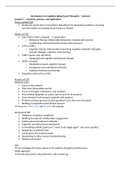Class notes
Summary of the lectures - Introduction to CBT
- Course
- Institution
This document summarises all the lectures from Miriam Lommen, it is quite important to have the lectures notes along with the summary of the literature. Eventhough there is a lot of overlap, there are some very important aspects in the lectures not covered in the literature.
[Show more]



